winter03
Back to VCBS First Page
INSIDE THIS ISSUE:
A Visit To West Charleston Poland Bridge Restoration Progress Comstock Bridge Reconstruction Completed
Marshfield Makes a Bridge Deal Marshfield's Martin Bridge Inspection Report
Brighton Vermont Pedestrian Covered Bridge Nears Completion Covered Bridge Community News Notes
Letters -- Interest in Bridges Yields Covered Bridge Mailbox Membership Column President's Column
|
by Irene Barna The Vermont Covered Bridge Society met October 25, 2003 at the Ilsley Public Library in Middlebury for its Fourth Annual Business Meeting. Twenty-five covered bridge enthusiasts signed-in at the meeting and enjoyed refreshments brought by Kathy Ramsey of Lyndonville. At 10:30 AM the meeting was officially called to order by Vice President John Weaver in the absence of President Joe Nelson. Minutes of the previous Annual meeting were not read since they had been printed in The Bridger; but motions to accept as published were made and seconded by David Guay & Jeannette Wilson, respectively, with no additions or corrections expressed. Self-introductions were requested and we welcomed visitors Richard Cormier of Clarendon, VT and Gerry Cormier of Agawam, MA. Nominations Committee Report The Nominations Committee Report was given by chair of that committee, John Weaver. After reading the names of those agreeing to assume those responsibilities, John encouraged all to submit ballots to the secretary at this meeting or to mail them before the deadline of November 15, 2003. John welcomed write-in votes as only one person was running for each office. Late ballots would not be counted.
The Treasurer's report was submitted by Ruth Nelson, Treasurer and was read by Irene Barna in Ruth's absence: Balance brought Forward Jan.1, 2003 $3914.54 Cash in 1 -1-03 to 9-30-03 $2502.10 Paid out 1-1-03 to 9-30-03 $1551.06 Cash on hand 10- 1-03 $4865.58 Expenditure highlights: Postage $455.31 Printing $245.10 Convention fee $210.00 Mtg Rentals $100.00 Office supplies $ 46.91 Misc. other $458.20 Total $1551.06 Membership Report The Membership Report was submitted in absentia by Trish Kane, Membership Coordinator, and read by Irene Barna: Total membership as of Oct 7, 2003 = 139 Total membership as of Oct 25, 2002 = 148 Of these memberships, 68 are residents of Vermont and 71 are from out-of-state. The breakdown of these memberships are as follows: Individual 64 Family 26 Life 23 Life Couple 5 Honorary Life 5 Business/Organization 4 Associate 2 Student 1 Courtesy 9 New memberships from January 1, 2003 to date are 27 compared to 30 at this time 2002. Personal e-mails and/or post cards were sent in August to members in arrears on dues one year or more. Memberships were terminated for those who did not respond. Other Reports - Bridge Watch: 1) Lyndon/Danville Bridge Watch: Kathryn Ramsey was welcomed as new bridge watch chair for the Lyndon-Danville area. 2) Green River Bridge Mail Boxes: Will Thompson reported on the status of the mail boxes in the Green River Bridge in Guilford. Two years ago Will had taken a visitor to view the mailboxes in the bridge because of their unique location. They found all of the boxes missing, having been removed by post office officials. Joe Nelson had received word from Mark Parmenter, the Postmaster in Guilford, that because of vandalism the Postal Department drop box was removed along with the several rural mail boxes. The president of the Guilford Historical Society, Addison Minot, contacted Mr. Parmenter about replacing the removed drop box. Contacts between the Brattleboro Post Office, Addison Minot, the Guilford Post Office, and Joe Nelson resulted in Guilford Post Office proposing to: 1. Install a dummy drop box with opening welded shut and an actual drop box nearby. 2. Place a working drop box in sight of the bridge, several yards away. 3. Have a 2004 ceremony with special cancellation from this location. A firm date of the ceremony in the spring, hopefully, can be announced in The Bridger. 3) Cooley Bridge: Neil Daniels, Neil H. Daniels, Inc. Construction being the low bidder on the project, reported that the work should be completed in about two weeks. 4) Hectorville Bridge: A motion to authorize $500 from the VCBS toward the restoration of the Hectorville Bridge in Montgomery was made and seconded by Rae Laitres and Marge Converse, respectively. The Town of Montgomery is still working out approvals and grant requests to put the project together as it is still in the formative stages*. It was reported that last summer there had been discussions in the Courrier as to what should be done. (*For those with internet access this site is informative http://vermont-towns.org/montgomery/hectorville.htm) Special Report--Toll House Windsor, VT: Sue Richardson is now the owner of the house located in Windsor, VT being the Toll House at the Windsor/Cornish Covered Bridge. Archaeological excavations have found evidences of a grist mill on Bridge Street in Windsor. During bridge and mill foundation excavations and renovations to the house, it was revealed that the house exists in three parts. Sue realized that the house had elements that needed to be shared and that the house belongs to history. Taking apart floors revealed architectural features, including a beehive oven, which could be explained to visitors. Sue contacted Joe Nelson wondering if the VCBS might be interested in participation to some degree. The House is a good spot from which to photograph the Windsor/Cornish Bridge giving opportunity for vantage points rarely accessed (most photos are taken from the New Hampshire side). This bridge was a significant part of early transportation in the USA. She has invited several people and organizations to join in committee, mentioning these: Neil Daniels, the Windsor Historical Society, the Cornish Historical Society, the American Precision Museum, and the VCBS. The committee would look into raising money to restore the house. They would also discuss sharing the knowledge of hand tools displayed in the American Precision Museum, types of which would have been used to build the house and the bridge. There are also significant Victorian elements in the house added in a "remodeling update" in the late 1800s. The house itself is divided in half: the east side is facing the bridge and the west side faces the town. Using the east side of the house for an educational facility and the west for tools display, Sue hopes to involve schools and provide an opportunity to learn about the tools and technology of the time period. Also the bridge abutment is available for study. The Toll House was used for the four bridges that have existed on the site. The 1790 cape has a basement door leading into an area having a fireplace far grander than any of the main floor fireplaces since the basement level accommodated the ferry--the original means of crossing of the Connecticut River at Windsor. A kitchen was added in 1920 and a new foundation poured under the kitchen portion. The president of the Mascoma Bank has restored a home in the area and is said to be interested in the project. A brochure is to be put together and application made for grant monies, 501C3 status, and having the Toll House placed on the National Register of Historic Places. It is hoped that it might be a part of the American Precision Museum, the VCBS, or for a library of covered bridge artifacts. Dick Wilson interjected that the entire Richard Sanders Allen collection is currently housed in the Windsor Library. Ideas are welcomed for procedure. Sue Richardson is the newest life member of the VCBS. New Business - Open Floor Topics: Dick Wilson reports: Richard Donovan is recovering nicely in a nursing home since October 19th. A Canadian book to be out in March 2004 featuring 200 photographs. The Hopkinton RR Bridge in New Hampshire has had repairs and fireproofing. John Conwell of Maine book: "Images of America" features Maine bridges. Dick offered a few copies of Walker's book "Ramblings" at a cost of $5.00. Neil Daniels reports this Bridge Watch item: A Weathersfield fund of $700,000 of Jeffords money to the repair the stone abutment of the Downer's Bridge. Neil states that Joe Nelson, in his book*, calls this abutment a striking piece of dry-laid stonemasonry as it is the width of the bridge and extends back 100 yards. The state, VAOT, recommends tearing out and re-doing!!!!!!!! THE HISTORIC STONE ABUTMENT WILL BE SAVED. Efforts of the Bridge Watch Committee illustrate what joint effort can accomplish. (* Spanning Time Vermont's Covered Bridges by Joseph C. Nelson p 169 - Ed.) Bob Cassidy mentioned bridge construction in Rutland City John Dostal raised the issue of fireproofing and questions the life of fire retardants. Program: The morning program consisted of an excellent slide presentation by Dick Wilson featuring his photographs of many Vermont bridges taken over the period of forty-some years. The photographs illustrated the many changes over the years--some subtle, some not. The Spring All-Member meeting of the VCBS will be held in Rutland. The meeting is planned for a weekend in early June 2004. Bob Cassidy will be arranging the details. Tenative meeting sites will be either the Rutland Public Library or the home of the Rutland Historical Society, the former Nickwackett Fire House. The Vermont History Expo 2004 will be the weekend of June 26 and 27, 2004 in Tunbridge. The VCBS will have their booth in the same location in the Floral Hall as 2001 and 2003. Volunteers to staff the booth are encouraged to participate so that a few don't have to do it all. Irene Barna is the VCBS contact person for this Vermont Historical Society event. We thank Kathy Ramsey for bringing the goodies and coffee all the way from Lyndonville. Fifty seven dollars were realized as profits from the raffle. Members took home many nice covered bridge paintings and memorabilia that had been donated by the members. The group broke about 12:30 PM as lunch was "on your own" in town. No one returned for a bridge tour of area bridges so the meeting kind of… just… ended……. Return to Top by By Phyllis Johnson, Chesapeake-Clipper Correspondent Leola Pierce loves to admire fall foliage, and during a 1993 sightseeing trip to western Virginia she discovered something that would inspire her to produce a book and seek state legislation to recognize what she saw. What attracted the Portsmouth resident's eye that fall day was a covered bridge still in use. It made her wonder how many covered bridges could be found around the state. So she and her son, Steve, who's worked as both a former private investigator and real estate agent, set out to document the structures in words and photographs. Her love of covered bridges came naturally to Leola Pierce, a retired Virginia Department of Transportation bridge engineer with more than 50 years of drafting and engineering experience. She first worked as an architectural draftsman then as a civil engineering draftsman at the Naval Operating Base in Norfolk. "I also worked as a senior structural draftsman specializing in bridges and then as chief draftsman in the Suffolk District Bridge Office of VDOT," said Pierce. "My last position was that of transportation engineer (bridges) up until I retired in 1995." Pierce, 80, and her son, 56, spent nine years visiting covered bridges and found nine: three in the south Piedmont area and six in the Appalachians. They captured them in a book titled "Covered Bridges in Virginia," which was published in the spring of 2002. The 165 page book includes historical information about Virginia and structural data on the bridges. Pierce's original poems inspired by the bridges, and picturesque as well as technical photographs of the structures - all shot by Steve Pierce. The book also includes maps, genealogy information and family data. The book explains how the first timber bridges were called corduroy bridges. Covered bridges were made by carpenters on dry land, taken apart and reassembled over the waterway. The bridges featured in her book are Meem's Bottom Covered Bridge. Biedler Farm Covered Bridge, Humpback Covered Bridge, Link's Farm Covered Bridge, Sinking Creek Covered Bridge, C. K. Reynolds Covered Bridge, Jack's Creek Covered Bridge and Bob White Covered Bridge. Marysville Covered Bridge was destroyed by Hurricane Fran. Meem's Bottom Covered Bridge is located between Mount Jackson and New Market and remains usable, said Steve Pierce. "There is so much traffic on it, it is unbelievable. There are UPS and Fed-Ex trucks everywhere." "The Humpback Covered Bridge in Covington is the oldest covered bridge in Virginia and the only covered bridge in the United States with a hump," he added. "There are three covered bridges in Giles County," Steve Pierce said. "Two of them are on private property, but we know the owners of them very well." Biedler Farm Bridge is the most protected. It is on a private farm and is rarely visited. C. K. Reynolds and Link's Farm Covered Bridges are also on private property. According to the book, private property owners have a difficult time renovating the bridges due to having to meet ecology standards and because techniques and materials consistent to the original structure can be expensive. Since the release of book, the number of enthusiasts for these covered bridges has grown, and in May she established the Covered Bridge Society of Virginia, which meets the third Wednesday of each month at the Western Branch restaurant. Steve Pierce said interest is building to hold a Covered Bridge Weekend at the Humpback Covered Bridge in Covington between the last week in May and the third week in June. And, he said, a Covered Bridge Day planned Sept. 27 at the Sinking Creek Covered Bridge in Newport. A resolution was passed by the General Assembly earlier this year to designate the third weekend in June as Covered Bridge Weekend in Virginia. That effort was sponsored by state Sen. Fred Quayle of Chesapeake, who also helped establish license plates commemorating the covered bridges. It takes 350 orders to begin production of these licence plates. Quayle attended the Covered Bridge Society's Aug. 20 meeting to discuss how selling the plates help in restoration efforts. "For every $25 spent on these, $15 will be allotted toward the restoration," he said. Quayle was named an honorary member of the society at the meeting, and he com mended Leola Pierce for her work in getting recognition for the covered bridges through her book. Joe Flasinski, a covered bridge enthusiast who is starting a chapter outside of Charlottesville, was among others who attended the meeting. Izzy de Jesus, a Deep Creek resident and president of the society, became interested in covered bridges originating with his love for photography. "I was out with a friend to photograph lighthouses up north, but it was too foggy for good photos of them, took a detour from my usual trek and stumbled across a covered bridge," he said. "We came across 10 different covered bridges." This piqued his interest and later he found an article about Pierce and her book. "She later tracked me down and asked me to join the society. I was then elected president". The group now boasts 15 members and Pierce is hoping to interest others in helping catalog and the bridges. "Please ask anyone who is intrested in our historic timber covered bridges to attend our meetings and join the Covered Bridge Society of Virginia and help promote the preservation and maintenance and memory of our bridges," said Leola Pierce.
Return to Top by by Charlie Elflein In the Northeast Kingdom of Vermont, situated between two of the state's most beautiful lakes (Willoughby and Memphremagog), lies the Town of Charleston. Settled in 1803, this remote corner of Orleans County was first called "Navy" in honor of Commodore Whipple who was the grantee. He fought in the navy at a battle in Charleston, South Carolina, and in 1825, the town name was changed in his honor.
Probably the most famous covered spans in town were the Twin Bridges spanning Clyde River in East Charleston. Situated near the village store and post office, these two were constructed with steeply pitched roofs to accommodate the frequent North Country snowstorms. About 1.5 miles west of East Charleston was the small Haystack Corners Bridge, a low queenpost truss also spanning the Clyde River With its unpainted siding, dirt road, surrounding trees and schoolhouse, this little bridge was typical of the many rural spans in Orleans County. Continuing westward on Route 105, we pass Pensioner Pond, Lubber Lake, then arrive in West Charleston. Nothing more than a small crossroads today, here we find the site of the former Power Plant Bridge. This covered span was located just a stone's throw east of the main highway on Durgin Road. This post card identifies it as Clyde River Bridge, but the Charleston Historical Society said the most common name is Power Plant. In this view looking west, Route 105 would be to the left of the picture. This scene truly has "rural Vermont" written all over it. I love the old wooden guard rails leading up the bridge, the weathered vertical siding, shingled roof, granite abutments, tranquil river, winding dirt road, and open pasture in the background. How we bridgers wish more places like this were still around to capture on film!
Power Plant Bridge was a four-panel combination queenpost and kingpost truss. Approximately 50 feet in length, it had square portals and unusual siding. The east side was boarded up 2/3rds of the way, whereas the west side only had vertical siding below the horizontal beam of the queenpost. This was done, no doubt, for greater visibility and more light inside the bridge. The Charleston Historical Society does not have a builder's name or record of when Power Plant Bridge was constructed, but a new span was built at this location in 1926. They assume the covered one was removed or destroyed at the time. While Orleans County remains one of the most rural regions of Vermont, most of its covered spans have met a fate similar to West Charleston's Power Plant Bridge. Let's hope that the two remaining old structures in Irasburg and Troy will be with us for many more years as a reminder of early bridge building in the region. Return to Top by Joe Nelson
Chord replacement at three of the four corners of the bridge is completed, said Ligon. He expects work on the southwest corner chord to be finished Monday. Two chord members in the center of the bridge and five kingpost replacements remain to be done, he said. New bed timbers will be placed under the chords at the abutments and the end timbers of the Burr Arches will be replaced to terminate at the face-walls. Work was stopped October 28 when the Lamoille River went out of banks and forced the construction crew to move equipment to high ground. The rains came again on November 18 causing the river to rise once more, peaking on November 20, the waters rising to within 14 inches of the center of the steel scaffolding supporting the bridge. Construction equipment at the north end of the bridge had to be moved again, including the trailers. Stacks of bridge timbers, floating away, had to be lassoed and tied to trees. The approach road to the north end of the bridge was washed out. Return to Top By Joe Nelson
Once the last of the construction details, such as final guard rail work, application of fire retardant, removal of office trailers, etc., are completed, the Construction Section of VAOT will schedule a final inspection of the project. Following that inspection any remaining problems or details brought up at that inspection will be completed and the project will be accepted. At that time the bridge will be turned back over to the Town and it will be opened to traffic. All of that should happen within the next couple of weeks. I also have been pleased with the quality of workmanship on this project. Return to Top Tax bill traded for scenic 120 acres on Route 2 by Sky Barsch, Times Argus Staff
That will be the case when the town officially assumes the deed of Charles Thorndike's 120 acres of property along Route 2, which include the historic wooden covered Martin Bridge. Thorndike, of New Hampton, N.H., is giving the town of Marshfield the property, which is valued at $87,200.00, in exchange for the $1,321.08 he owes in current school taxes. The selectboard voted last week to agree to the deal, and plans to sign the deed agreement Tuesday. "We accepted the bridge because it's historic and it was offered," said Marshfield Selectboard Chairman George Longenecker. Another reason, he said, is, "One of my interests is history and historic preservation." Longenecker said he believes there is grant money available to preserve what he calls one of the most historic places in Marshfield. The Martin Bridge crosses the Winooski River and is on the National Register of Historic Places. It is the only covered bridge left in Marshfield. Historians believe the 45-foot long bridge was built in 1890. Though the bridge is unsafe for automobile travel, it serves as a handsome backdrop for a popular fishing spot. The land included in the exchange is zoned in the flood plain or in forestry, making the land unsuitable for development. Town officials are considering selling a portion of the property. Longenecker said the town will discuss what to do with this and other properties the town has acquired through tax sales. "We don't need 120 acres of land," Longenecker said. Attempts to reach Thorndike were unsuccessful. (Copyright © 2003 The Barre-Montpelier Times Argus, www.timesargus.com Contact Sky Barsch at sky.barsch@timesargus.com or 802-479-0191, ext. 1153. - Ed.) Return to Top by By John Weaver After reading about the gift of the Martin Bridge to the town: "Marshfield Makes a Deal", in the Barre-Montpelier Times Argus, John Weaver contacted George Longenecker, Marshfield selectboard chairman. Weaver, a Professional Engineer and Bridge-watch Coordinator for the Vermont Covered Bridge Society, volunteered to evaluate the bridge at no cost. The following report was sent to the Town of Marshfield Selectboard. Bridge name(s):Martin Bridge, Orton Bridge World Guide Number: 45-12-06 Inspection date:11/01/03 Location: Marshfield VT. Type: 45' Queenpost. Use: No vehicle use. The overall conditions of the dry rubble masonry abutments and wings are poor. In particular, considerable (river) undermining and settlement of the northwest and southeast corners are evident. Individual stones indicate noticeable dislocation and large open gaps between stones appear in many places at both abutments. Overflow areas in adjacent fields seem to provide some channel flow relief during flood events. The wood superstructure demonstrates some merits: The roof seems to be tight enough to keep most of the structure dry, also, it has ample overhang and pitch. The siding is in fair condition and provides venting at roof soffit locations. The superstructure shows some evidence of repairs and maintenance over the life of the bridge and still maintains a positive camber. However the bottom chord indicates heavy areas of rot at the end diagonal joint locations and bearings. Due to this rot and settlements of abutment stones, the trusses have settled (distorted) and do not bear on the abutments in a satisfactory manner. The entire bridge is racking (very noticeably) toward the upstream side. Many truss joints are loose and distorted. The floor system is missing planks and the floor beams are spread very far apart. The queen posts seem to be connected to the bottom chords with metal straps - this was probably not the original design. Judging from experience with Randall bridge in Lyndon, the cost of underpinning each abutment would be approximately $16,000. Rehabilitating the upper portions of each would probably cost the same, for a total abutment cost of $64,000. Repairing truss members, flooring, floor beams and aligning the wooden superstructure would probably cost approximately $25,000 - $30,000, for an overall total of approximately $94,000. It is recommended that all wood members on the inside of the bridge be treated with a surface application of fire retardant. Per site visit the bridge appears to be salvable, that is, to rehabilitate it to some stable condition. However, even rehabilitated, the structure may have only somewhat limited load capacity beyond carrying its own dead load. Final use and load capacity would have to be determined by a professional engineer. For now, continued deterioration of the foundations will probably cause further distress in the wooden superstructure, leading to its eventual collapse. Return to Top By Sean James
After many years of hard work by the Town of Brighton and support from the Vermont Agency of Transportation, the Brighton Pedestrian bridge is nearing completion. The bridge consists of three sets of elevated wooden stairs on timber piers, a 112 foot long Howe truss main span and covered stairs on grade. The total length of the covered portion of the bridge and approaches is 327 feet. Design of the bridge and construction inspection are being completed by Hoyle, Tanner & Associates. The grand opening is scheduled for the end of September. We will forward the date and time once it has been finalized. Sean T. James, P.E. Project Manager Hoyle, Tanner & Associates, Inc. 150 Dow Street Manchester, NH 03101 mailto:sjames@hta-nh.com http://www.hoyletanner.com Return to Top Work on Buskirk Bridge Begun (WGN 32-42- 02)
The county wants to build a new bridge to augment the covered bridge and has applied to add the new bridge to a federal transportation package that will be available in 2010. A location for the new bridge has not been determined. The covered bridge spans the Hoosic River, joining Rensselaer and Washington counties. For commerce and emergency services, it is important that a bridge be available at all times. The community around the bridge is served by the Buskirk Fire Department on the Rensselaer County side. When the covered bridge is reopened it will be rated for 12 tons. A new steel bridge will carry 25 tons, sufficient to support emergency vehicles. [Our thanks to Dick Wilson for forwarding the news clipping on which this report is based. For a history of the Buskirk Bridge since the August 2002 closing see the two Buskirk stories on the VCBS website: www.vermontbridges.com/newspage.htm - Ed.] Wind-toppled tree smashes roof of Forks Twin Span (WGN 38-19-10, 11) September 5, 2003 - Sad news again. Just learned that the Delta Covered Bridge in Keokuk County, Iowa was arsoned on Wednesday night about 8:30 p.m. Ironically or perhaps intentionally, the bridge was arsoned exactly to the day that the Cedar Bridge was arsoned in Madison County a year earlier. For more info go to www.theiowachannel.com. You can view some photos of the burned bridge there. Sincerely, Tomas E. Walczak [The 76-foot Delta covered bridge was built in 1869 using a Burr truss to cross the North Skunk River at Delta, Ia. - Ed.] Hogback Bridge Fired (WGN 15-61-04) Madison County Arson The Beausejour Bridge Taken Down (WGN 61-58-07)
The chords have been cut at the floor level and trestle in the middle. The bridge has been loaded on two floats for the move to Amqui and storage. This is a bridge I do not see anymore as "historic". It is a shame to do such a job. Sincerely, Gerald Arbour Return to Top
Hi Joe, I have always been interested in bridges growing up and the first design exposure I had was in college in a strength of materials class. The task was to build a truss out of raw sheet metal to hold 100 lbs. I chose a Parker truss to build and found all the tension and compression members. From there I found all the loads on the members using the pin method and then calculated the width of each member. The bridge went together well and held the 100 pounds fine. It was a very rewarding project.
Timothy Turner Return to Top
|
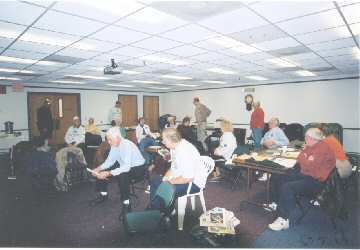
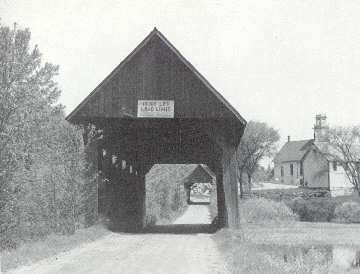
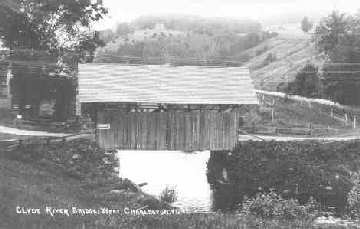

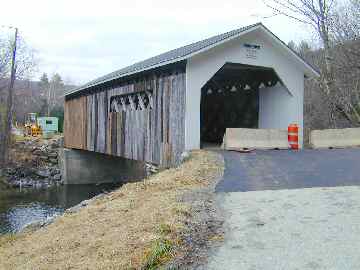
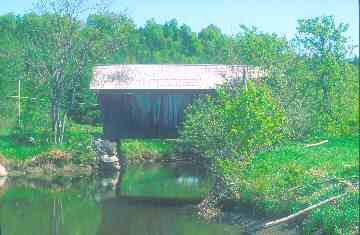
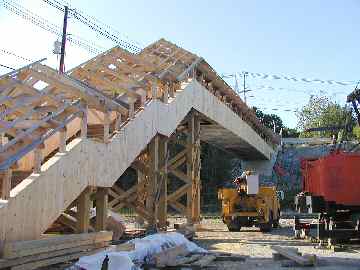

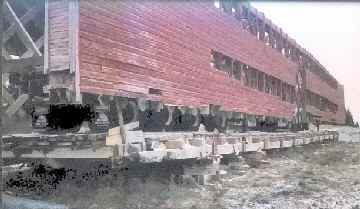

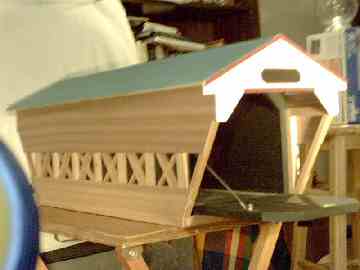


 Joe Nelson, P.O Box 267, Jericho, VT 05465-0267
Joe Nelson, P.O Box 267, Jericho, VT 05465-0267